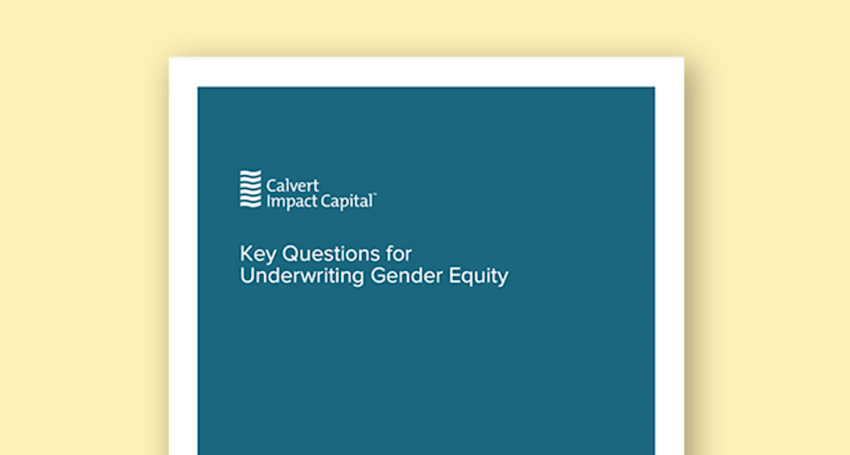
Key Questions for Underwriting Gender Equity
March 08, 2018
“How do you invest with a gender lens?” This is one of the most frequent questions investors ask us. This year, with support from Shell Foundation, we’ve organized a series of investor gatherings to share some of our lessons learned.
During these gatherings, we share two tools to help investors adopt a gender lens: 1) An asset class framework, and 2) A due diligence framework. The first framework encourages investors to develop their strategy—whether for gender-lens or impact investing more broadly—by focusing on the capital they have available to invest. We encourage investors to ask themselves three essential questions:
-
What kind of capital do I have (Debt or equity? In private or public markets? Philanthropic capital)?
-
Where it is housed (A large firm? Family office? Foundation?)?
-
How much do I have (The opportunities available to you expand with the size of your investable assets; retail investors generally have less options than accredited investors)?
The answers to these questions help the investor practically define the opportunities available to invest for impact.
Context Matters
The second framework is built from our experience as a lender, and highlights some basic questions that can be asked during the underwriting process. The framework is not an exact replica of our processes and is not comprehensive. It’s meant to serve as an example, offering basic questions that can be a starting point for incorporating gender into an investment selection process. Questions must be refined and adapted based on experience and depending on the deal being reviewed.
These questions are born out of the following:
-
The market we operate in (capital markets);
-
The kind of capital we invest (private debt), and;
-
The theory of change we have developed for the sector in which we are exploring gender equity in depth (to use private capital to achieve gender-equitable outcomes in the context of universal energy access).
Calvert Impact Capital places investor capital with both financial and impact integrity. We ensure that our investments are creating measurable social and environmental outcomes, but the first hurdle any investment must clear is financial (i.e. will we get our money back?). The reason we ask questions about gender equity is not because we are passionate about gender equity (although we are) or because we believe this impact is inherently more important than others (we don’t). We ask these questions because we believe they are critical to understanding a business’s strategy and potential for success. In the off-grid energy sector, gender questions help clarify if investees are seeing the full market opportunity or if they might be missing a substantial portion of their potential customer base. Businesses who intimately understand their customer base can reach them more effectively. More broadly, research has shown us that diverse businesses are smarter businesses.
We have two types of investments in our portfolio. The bulk of those investments (85%) are in intermediaries and the remainder (15%) are in businesses or projects. Depending on which type of investee we are talking to, we ask different questions.
On the left side of the framework, in red, are the questions for intermediaries. When we invest in an intermediary, our goal is to help them access traditional capital markets directly, so they can scale and increase the impact they and their borrowers are creating. We recognize that we are far removed from the “on the ground” activities when investing in intermediaries, and that our primary impact is systems change: facilitating local financial market creation, growing sector activity, strengthening impact business models, and helping to leverage additional investor capital. As intermediaries grow their operations with help from our investment, we have a multiplier effect on the impact that the intermediaries’ target clients create. We underwrite our partners’ ability to work with their clients to determine the best approach to creating and monitoring the impact on the ground, but we aren’t directly involved ourselves. The questions we ask and the metrics we request from this kind of investee reflect this understanding.
On the right side of the framework, in blue, are sample questions for direct investments in businesses or projects. These questions are appropriate for funds or intermediaries to ask their borrowers. With an operating business or project, an investor can be more engaged in setting the strategy for impact, as they are much closer to on-the-ground activities.
There is no “one right way” to adopt a gender lens
There is no a magic formula for gender-lens investing. These questions offered in the framework are merely starting points for a deeper conversation that has no right or wrong answer. Just because a potential investee lacks an awareness of gender equity doesn’t mean that they don’t currently have a positive impact on women (they might not acknowledge it as anything other than business as usual) or that they can’t or won’t shift their operations to be more gender-inclusive and as a result produce a powerful impact. The top section of this framework “Screening & Fit” outlines the broad, inclusive screens we use when developing our pipeline. In our experience, being inclusive has much greater potential for impact than setting rigid screens and potentially excluding good opportunities. Gender impact is both difficult to isolate and extremely contextual. Being open-minded and being responsive to the data we collect has served us well.
Conclusion
Gender isn’t a sector and it isn’t an asset class; it cuts across these categories and more. As the name “gender lens investing” makes clear, gender is a lens—a way of seeing that helps an investor highlight opportunity, illuminate risk, and understand strategy in a more nuanced way. Ultimately, gender equity is not only an important impact goal as highlighted by SDG 5, but a critical tool that has the potential to make all of us better investors.
If you're interested in downloading the underwriting framework, please provide your name and email.




